Katsumi Sunamori – Implications of the Scenery (3)
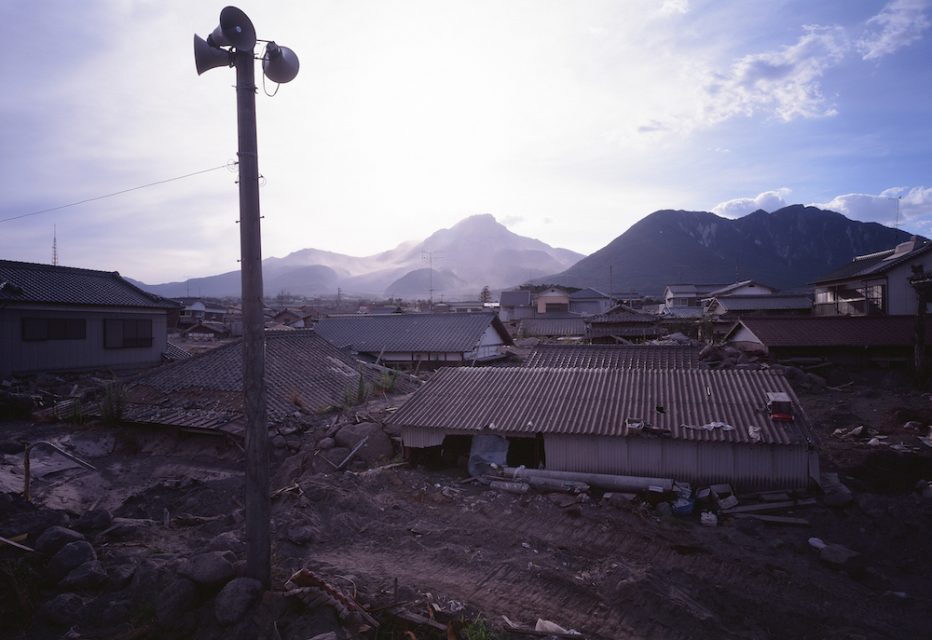 Katsumi Sunamori – From the series “Unzen, Nagasaki” (1993-95)
Katsumi Sunamori – From the series “Unzen, Nagasaki” (1993-95)All images: © Katsumi Sunamori Photography Office
I came to know about Katsumi Sunamori’s photo series concerning the Mount Unzen disaster site completely by chance. Although when I look back on it now, perhaps it was not necessarily a coincidence. As indicated by the fact that for some time after the Tohoku earthquake and tsunami I continued writing this column, “Notes on Art and Current Events,” with the subtitle “A Restatement: The Art of ‘Ground Zero,'” since March 11, 2011, my concerns as a critic have always had some connection to disasters. That I was invited to participate in a public talk with photographer Tsuneo Enari during “After the Tsunami: The Great East Japan Earthquake” (August 11-September 2, 2018), a solo exhibition on the subject of the earthquake and tsunami featuring his photos of sites in Tohoku’s Sanriku region hit by the tsunami held at the Sagamihara Shimin Gallery, was because Enari read my work on the Tohoku earthquake and tsunami and on the related topic of the environmental degradation of Mount Buko in my hometown of Chichibu [included in Shin Sasakubo, Mt. Bukoh: For Children of the Future (Kirasienne, 2017)] and resulted from an exchange of letters followed by a visit to Enari’s house during which we exchanged opinions on disasters and radiation exposure.
Leaving aside the details of the public talk with Enari, in the audience that day was Kazura Sunamori, the eldest daughter of Katsumi Sunamori, with whom Enari was acquainted prior to his death. At the end of the talk, she came up to me and introduced herself and explained how she was putting her late father’s photos in order. After returning home, curious as to what kind of photographer he was, I looked into Sunamori. And so it was that I came to learn about the photographer Katsumi Sunamori, a name that was completely unknown to me until then. But if that had been all, my interest may have ended there. The reason I thought about digging deeper was because I discovered in the chronological record of Sunamori’s career the item “1995, ‘Mokushi no machi‘ (Town of Revelation) exhibition of photographs taken at the site of the Mount Unzen/Mount Fugen eruptions in Nagasaki (Ginza Nikon Salon, Osaka Nikon Salon).”
I have already written about how the large-scale pyroclastic flow at Mount Unzen/Mount Fugen that caused numerous casualties has remained clear in my memory. Related to this, I published Shinbijutsuron (Earthquake art theory) (Bijutsu shuppansha, 2017), which includes a study of the eruption of Mount Ontake that occurred without warning in 2014 and killed 58 people, making it the worst volcanic disaster in Japan since the war. In the same book I comment at length on the historical parallel relationship in Japan between natural disasters and art (expression), and with regard to the Heisei eruptions at Mount Unzen I mention the volcanologists Maurice and Katia Krafft who lost their lives in a large-scale pyroclastic flow that occurred in 1991 as well as touching on it in another book, Introduction to Outsider Art (Gentosha shinsho, 2015), and so I was naturally very interested. The reason Kazura Sunamori attended the talk with myself and Enari was also probably because she was interested in these writings of mine. However, as someone who is neither a volcanologist nor a geologist, I had no real motive for entering the disaster zone unless it was through the medium of expression, and in fact I had been unable to find any photographic works that depicted the Mount Unzen eruption and the disaster area as individual expression as opposed to reportage or official records. It was in this context that the photographer Katsumi Sunamori appeared before me somewhat unexpectedly along with the name “Unzen.”
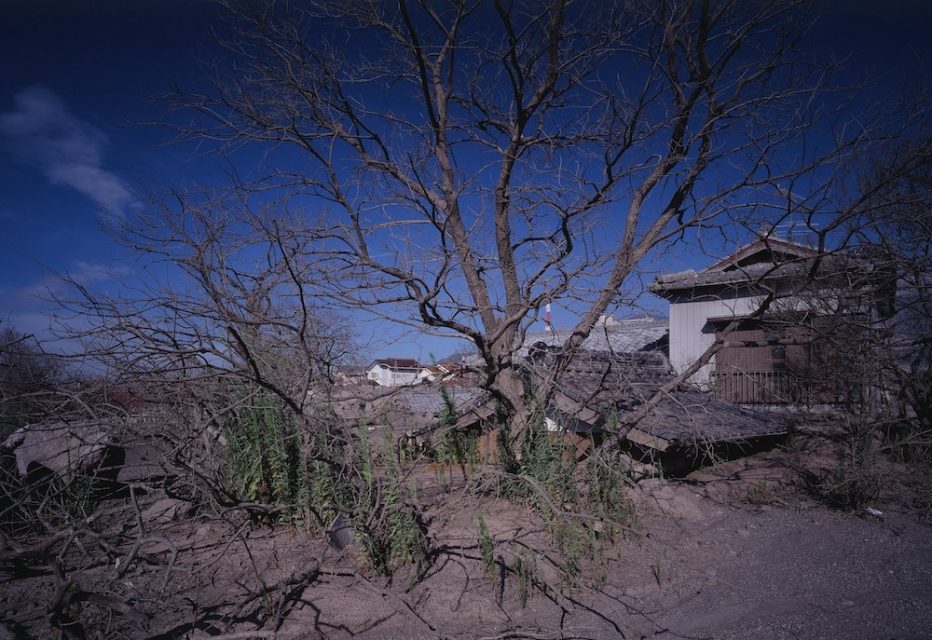 Katsumi Sunamori – From the series “Unzen, Nagasaki” (1993-95)
Katsumi Sunamori – From the series “Unzen, Nagasaki” (1993-95)
But at that time I still had no idea what kind of photographs Sunamori had taken on the subject of Mount Unzen. Intrigued, I sent an email to the address for Kazura Sunamori I had been given at the talk. I waited for a while without getting a response. Then, when I had almost completely given up hope (it was an address she did not check very often), a reply appeared in my mailbox that led to my being blessed with the opportunity to encounter not only Sunamori’s photos of the Mount Unzen disaster site, but also a collection of photos covering remarkably diverse domains, fields and places left behind by a photographer throughout a life that was by no means long. These photos were so wide-ranging it was almost unthinkable that they had all been taken by the same photographer. Nevertheless, my interest was focused mainly on the series of disaster site photos concerning the Mount Unzen eruption, which were the most varied and had not been shown in public. For this and other reasons I contacted Yutaka Kanbayashi, the editor in charge of the publisher Getsuyosha who knows a lot about photography and has been a friend of mine for a long time. Together with Kazura Sunamori, who for some time had been wanting to visit the Shimabara Peninsula where Mount Unzen is located, we made arrangements to travel to Shimabara, to which Sunamori had once been making visits to take photos whenever he had the opportunity in much the same way he had done in Kamagasaki, intending to be there for the Day of Prayer. Which is why the first of this three-part series of columns on Katsumi Sunamori began with a description of our arrival at Nagasaki Airport on our way to Shimabara.
From Nagasaki Airport we crossed the bridge over Omura Bay and headed south via Isahaya in the opposite direction from the city of Nagasaki, making our way from the gateway to the Shimabara Peninsula to the site of the volcanic eruptions via a route that took us through the famous hot spring resort of Obama on Tachibana Bay before traversing the perimeter of Mount Unzen itself. Shimabara was both the site of major protests (ordeals) by Christians in Japan culminating in the Shimabara Rebellion, and the place where priests who came to spread the Gospel were martyred after being tortured in the so-called “Unzen hells,” where boiling water bubbles up from the earth and where believers, most of them extremely poor peasants, who faithfully adhered to their teachings, converted (apostatized) after being similarly tortured. Later, those Christians who still did not abandon their faith left Shimabara and were dispersed in the Goto Islands across the sea and beyond the reach of their pursuers, but that is another story. Shimabara is also the site of Hara Castle, where Amakusa Shiro took up arms and holed up to the end, along with numerous other historic remains from this period. The castle has been designated a World Heritage Site, so more than a few people will have probably visited it.
But that is not all. As indicated by the description of the large-scale eruptions of Mount Unzen in 1991 that brought about the severest state of affairs as the “Heisei eruptions,” there are previous examples of similar major disasters in the past. Not only that, but on May 21, 1792, during the Kansei era, Mount Tengu, a peak on Mount Mayu that rises up behind what used to be the castle town of Shimabara, collapsed due to an earthquake that occurred during eruption activity at Mount Unzen-Fugen (325 million cubic meters of earth, the equivalent of nearly one-sixth of Mount Mayu, came down), producing a debris avalanche that engulfed villages at the foot of the mountain and continued as far as the Ariake Sea, where it generated a rare megatsunami (reaching a height of 23.4 meters at Kawachi in Kumamoto) that suddenly descended on villages along the coast. Referred to in Japan as “the Shimabara catastrophe affecting Higo,” this disaster killed some 15,000 people (including 5251 in the Shimabara castle town and around 3500 in the southern part of the Shimabara Peninsula), and is regarded as one of the largest volcanic disasters ever to have struck the Japanese archipelago, where natural disasters are not uncommon. The reason why “affecting Higo” is included in the Japanese name for this event is that it affected a wide area beyond just Shimabara, with the destruction caused by the tsunami extending as far as the coast of Higo Province (Kumamoto) on the other side of Ariake Bay. As well, as a result of the earth that flowed into the sea at this time, the topography of the eastern half of the Shimabara Peninsula and the bed of the Ariake Sea changed dramatically. Mayuyama Memorial Park and Chichibugaura Park are among several historic sites preserved as relics and memorials to the victims of this disaster.
However, such instances of “damage” are above all damage from a human point of view, and essentially it is through such dynamic activity that nature has been dispassionately and ruthlessly formed. Only when human livelihoods are caught up in these dramatic upheavals do we use the term “disaster.” All we can do is ready ourselves for these events of nature that may happen at any time and ensure we are always prepared both mentally and physically to keep the damage to a minimum in the name of “disaster prevention” and “disaster reduction.” The following is from a pamphlet titled The Shimabara Catastrophe: The 1792 Eruption of Mount Fugen and Collapse of Mount Mayu (2003) published by the Unzen Restoration Project Office of the Ministry of Land, Infrastructure, Transport and Tourism’s Kyushu Regional Development Bureau with the aim of ensuring “everyone including coming generations can deal with disasters that can occur at any time in their lives.”
The Mount Unzen volcano group, including Mount Fugen, has been active since before humans appeared on earth. Volcanoes form mountains by emitting lava and other material from beneath the earth’s surface, and through repeated erosion/collapse they form plains at their base. Because the slopes of mountains formed by volcanoes are steep, rockslides or collapse can occur at any moment. Sometimes they trigger large-scale collapses. Mount Mayu, which collapsed in 1792, was originally a lava dome created 3000-5000 years ago. The Shimabara Peninsula has been created as a result of this repeated formation and collapse of mountain forms.
Instances of volcanic activity at Mount Unzen in historic times include an eruption in 1663, the series of activities that began in 1792, and the Heisei eruptions. (The Shimabara Catastrophe: The 1792 Eruption of Mount Fugen and Collapse of Mount Mayu, p1, underlining added)
In other words, the large-scale pyroclastic flow at Mount Unzen (Mount Fugen-Heisei Shinzan) that appeared to occur out of the blue in 1991 in fact occurred 200 years after the Shimabara Catastrophe of the Kansei era. However, in terms of a geological time, which to humans seems vast, it was just one of the countless everyday “physiological phenomena” that occur intermittently on earth. Viewed in the context of such literally natural phenomena, human activity seems incredibly small. In an age when the kinds of disaster-prevention technologies and disaster-reduction insights we have today did not exist or were not widely known, people could only pray and wait until nature’s fury subsided. In fact, in various locations along the east coast of the Shimabara Peninsula and the coast of the Kumamoto region on the opposite side of the Ariake Sea, pagodas built by local officials and volunteers to honor the memories of the victims who washed ashore everywhere, and boulders deposited by the megatsunami and left to warn later generations of how far it reached, still remain. Today, in the aftermath of the Tohoku earthquake and tsunami, we cannot afford to ignore such “old tales” that seem to be half truth and half fiction. Even now, surely it is not the case that the things we can do will make no material difference.
And so, as I set foot on the Shimabara Peninsula and had a look round not only at the somewhat peculiar landscape formed by Mount Unzen and the remnants of the disaster, but also at the numerous small but memorable historic sites nature carved into the land with the help of humans, I came to sense that the disaster photos Sunamori took at Mount Unzen are not merely the record (expression) of a single photographer. For they also seemed to include a “revelation” to the people who were robbed of a place to live or lost family members or relatives as a result of the persecution of Christians and the large-scale natural disasters, or were forced to leave their hometowns to start their lives anew and ended up moving to strange lands where discrimination and poverty awaited them. Thus I wondered exactly what Sunamori meant by the term “revelation” (mokushi).
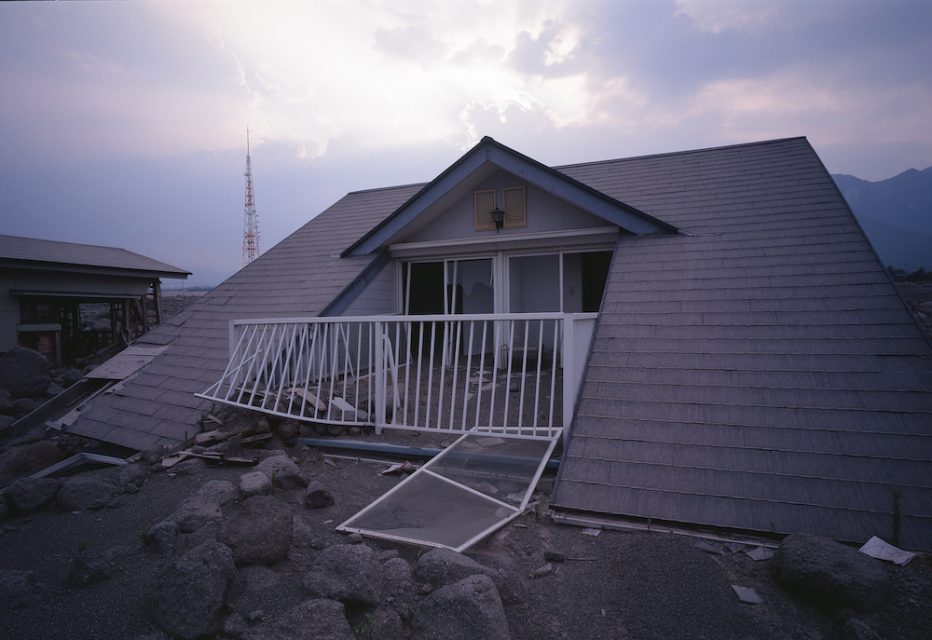 Katsumi Sunamori – From the series “Unzen, Nagasaki” (1993-95)
Katsumi Sunamori – From the series “Unzen, Nagasaki” (1993-95)
Why did Sunamori call his Unzen series “Mokushi no machi” (Town of Revelation) in the first place? Towns that became uninhabitable and empty due to radioactive contamination in the nuclear disaster that followed the Tohoku earthquake and tsunami were often described by heartless people as “towns of death” (shi no machi). Disaster sites where human activity has ceased are suddenly shrouded day and night by a silence that conveys no sense whatsoever of the pulse of life. And though I just described people who use this phrase as “heartless,” at the same time such places do call to mind “death,” and in this sense perhaps they do seem to clearly “reveal” a tragic state. However, as indicated by its use in the Book of Revelation to John (otherwise known as the Apocalypse of John), in a religious context the word “revelation” originally referred to an “apocalypse.” In which case I cannot help but wonder if perhaps the title Sunamori gave to the disaster site in Shimabara, “Mokushi no machi” (Town of Revelation), also has a religious nuance.
As can probably be imagined given that his father was born in the Philippines, which was once a base in Southeast Asia from which the Jesuits propagated their teachings, Sunamori was in fact a Catholic who had a Christian name (none other than “John”). According to Kazura Sunamori, though he never said anything about it in public, Sunamori had a strong religious faith and spoke during his lifetime of his belief that one could gain peace of mind by attending Mass. After he was diagnosed with cancer, he also expressed a desire to return to live in Amami Oshima where he lived as a boy and photograph the extremely simple churches that still remain here and there on the island. Though he was unable to realize this dream, the fact that for Sunamori, who was aware that his own death was approaching, the things that he wanted to photograph last of all were these humble churches (chapels) in Amami Oshima provides an extremely important point of view in terms of reassessing the work this photographer left behind.
Or perhaps after abandoning his work as a photographer chasing scandals, happening to visit once for work and then going back again and again to Shimabara, a place that had gone through numerous ordeals, was an opportunity for him to face up to the faith that was fundamental to him not merely as a photographer but as a single human being standing before God. For example, displayed in a gallery at the Mount Unzen Disaster Memorial Hall is the Rolex watch worn by Tadaomi Tsuchiya, a contract photographer for the weekly pictorial magazine Focus, up until the time he lost his life in the 1991 large-scale pyroclastic flow. Sunamori likely saw this watch. And perhaps he glimpsed in it something of his former self. Or perhaps he reflected on the vicissitudes of fortune whereby it could easily have been him who lost his life on the fateful day. Perhaps he even thought that as a photographer who survived according to God’s will, it was his duty to pass on to coming generations images of the Mount Unzen disaster site by way of photographs.
If we widen our field of vision geographically and temporally, due to its topography, the port of Kuchinotsu, located in the part of the Shimabara Peninsula known as Minami Shimabara, flourished from long ago as a harbor where ships from afar could anchor. Historically it had been one of Japan’s busiest ports, welcoming ships from Europe in the late 16th century and serving as a transit port for the export of coal mined at the Miike coal mine in Kyushu by the Mitsui zaibatsu in the modern era. At the same time, to satisfy the demand for labor, people moved en masse from Yoron and other islands to the south, requiring them to leave their homes and live in harsh conditions. This undoubtedly included Sunamori’s home of Amami Oshima. And it also extended to the so-called karayuki-san who stowed away on coal transport ships and worked as prostitutes in such faraway places as Singapore and Malaysia to earn a living. Materials related to this history are displayed at the Kuchinotsu History and Folklore Museum and Sea Museum (the former Kuchinotsu Branch Office of the Nagasaki Customs House). (Incidentally, the song “Shimabara Lullaby” is a lament for these karayuki-san.)
And so in this part of Japan, a cruel history – similar to the world Sunamori witnessed in being abandoned by his father at a young age and losing his mother through illness, giving up on a career as a boxer after working so hard to achieve it, learning how to use a camera and photographing atomic bomb victims in Hiroshima while working and finally arriving at “the sun” (kama tida) of the day laborers at Kamagasaki – lay, heavily condensed, at every turn. And the sea route from Okinawa to the Philippines via Shimabara that skirted Amami was truly a one-way route in that the karayuki-san who sold themselves into prostitution could not return to their homes. In other words, Sunamori’s personal history up to this point was not his alone. Even though it did not occur as he once imagined, after achieving his goal of being reunited with his father, Saberon, this took on increasingly greater meaning inside of him and undoubtedly motivated his actions until his death. Looking at the photographs Sunamori left behind, such thoughts come to me extremely naturally.
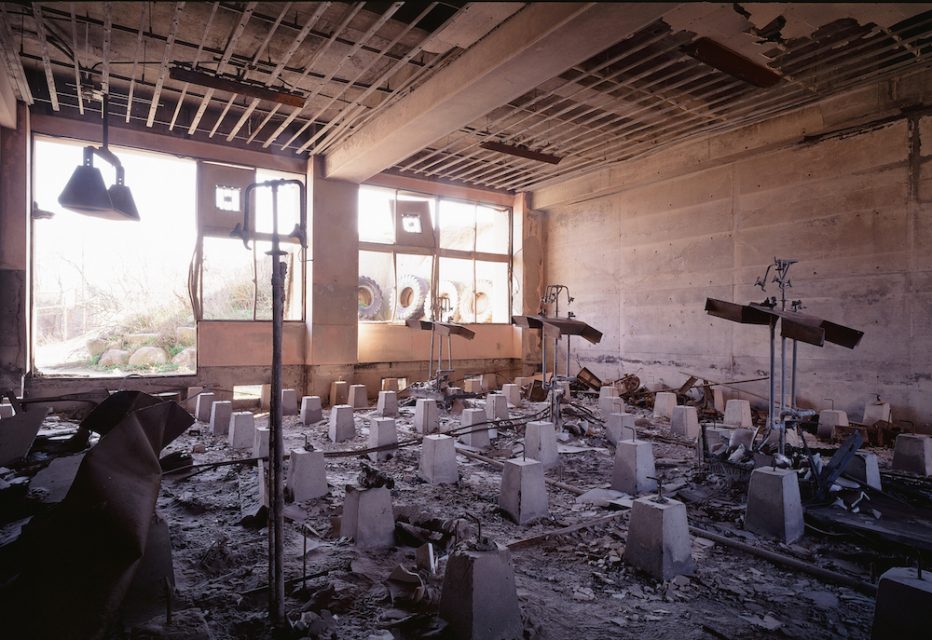 Katsumi Sunamori – From the series “Unzen, Nagasaki” (1993-95)
Katsumi Sunamori – From the series “Unzen, Nagasaki” (1993-95)
However, no doubt Sunamori also had feelings that cannot be clearly explained by such an argument. Perhaps after losing his father, Saberon, the more Sunamori’s faith ascended to Christ as the father of all those who suffer and became a more universal emotional foundation, the more he came to harbor doubts concerning the cruel blows on earth employed without mercy by the Creator of heaven and earth, or perhaps we should say the destroyer of heaven and earth, whose powers easily exceed those of personified gods such as volcanoes, and concerning the silence of God who makes no effort to give charity in response. This is a difficult theological problem, and a question that has been asked continuously since ancient times, but for those of faith who are sincere, it is the kind of question they might reasonably entertain more strongly than most. And it relates not only to the victims of natural disasters. Exactly what kind of “good tidings” were there in the existence of Korean victims of the atomic bombings who suffered unreasonably while receiving no assurance whatsoever from the perpetrators; the day laborers who froze to death on the streets of Kamagasaki; the Christians who were forced to renounce their faith after being immersed in boiling water bubbling up from the Unzen “hells”; and the women who were torn away from their homes, cooped up in the bottoms of ships and forced into prostitution in strange lands? Or perhaps before nature in all its vastness, both the “good tidings” of God and the existence of these things amount to absolutely nothing. It would not be strange at all if Sunamori felt there was a road to salvation here, albeit not great. And all he could do was photograph these using “the pencil of light” (kama tida).
When I thought about this, I wondered if behind Sunamori’s aversion to fighting and reluctance to hit people since childhood while distinguishing himself as a boxer to the extent that he almost took the title of Western Japan Rookie of the Year was his preference to be struck rather than to strike, or in other words, “if anyone slaps you on the right cheek, turn to him the other also.” (Gospel of Matthew) In fact, an essay by Kazura Sunamori includes the following passage: “A classmate from junior high school who knew him at the time says of Sunamori, ‘He was a skilled technician and had stamina, but because he was so kind I think he grew to hate it because he was unable to hit another person with hatred.’ His wife, Hitomi, also said, ‘ He told me it was hard for him to hit people even if it was a sport.‘” (From “Shashinka Sunamori Katsumi ga mitsumeta Kamagasaki no taiyo” (The Kamagasaki sun that photographer Katsumi Sunamori gazed at), underling added.) But was this simply because Sunamori was “kind” by nature? Perhaps it was because he was constantly wavering between his self that was endowed with the “power of nature” – equipped with a tough body bestowed on him by this same heaven and possessed of sufficient skills and resources to ruin an opponent’s body, or to put it another way equipped with the skills as a photographer to take the kinds of shots that would ruin another’s privacy and bury and be done with them socially – and his self that rejected this completely and sought the “peace of mind” that comes from the self-realization of one’s ethical mission to bring salvation and peace to all people, that resulted in him seesawing between the qualities of extreme close-ups and coolheaded long shots that we see in his photographs.
I am reminded of the literature of Shusaku Endo, a novelist who, as a Christian like Sunamori, expressed through his works an inner self bitterly torn between an idealistic belief in the absolute virtue practiced by Jesus Christ and his actual feelings as a person living in Japan where everything was contained within nature and power beyond human intellect had to be discovered in the whole of creation. In his acclaimed novel Silence, Endo also depicted the hidden emotional turmoil of the Christian peasants who hid in various locations around Nagasaki and underwent extreme physical torture to the point where they were martyred in a fashion that resembled being buried in nature, and of the Portuguese missionaries who, unable to overlook the sacrifice of these followers, ended up stepping on fumi-e (flat images of Christian icons) in an effort to remain consistent with their own faith by betraying God. Here, deciding whether something is “right or wrong” is not easy like it is in the West. Come to think of it, the movie adaptation of this book directed by Martin Scorsese opens with a scene of Christians being tortured in the boiling waters of one of the Unzen “hells.” Moreover, the “silence” of the title is a word that symbolizes not so much the “revelation” of the Apocalypse, but a fundamental skepticism of “God’s silence” while offering no charity whatsoever.
Dispensing with superfluous emotion, Sunamori photographed the completely destroyed disaster site at Mount Unzen in Shimabara coolly from a distance in an effort to show it without telling a lot. This approach is similar but different from that of Kama Tida, in which he tried to shine the light of the sun on all of the laborers who live in Kamagasaki. Which reminds me that when Sunamori said, “Through my lens, I wanted to at least provide them with some ‘sunlight,'” he also used the term komyo (the light of grace emanating from Buddha), a word that has strong religious connotations. Contrarily, it is quite within the bounds of possibility that the term “revelation” in “Town of Revelation” means something similar to Endo’s “silence.” In his novel, Endo wrote the following about the inner struggles of the missionaries when they witnessed the world demonstrating no change whatsoever despite their followers who had suffered adversity due to their faith having been crushed like insects and executed in an instant:
Yet his perplexity did not come from the event that had happened so suddenly. What he could not understand was the stillness of the courtyard, the voice of the cicadas, the whirling wings of the flies. A man had died. Yet the outside world went on as if nothing had happened. Could anything be more crazy? Was this martyrdom? Why are you silent? Here this one-eyed man has died – and for you. You ought to know. Why does this stillness continue? This noonday stillness. The sound of the flies – this crazy thing, this cruel business. And you avert your face as though indifferent. This… this I cannot bear.
(Shusaku Endo, Silence, trans. William Johnston, Picador, 2015, p. 160)
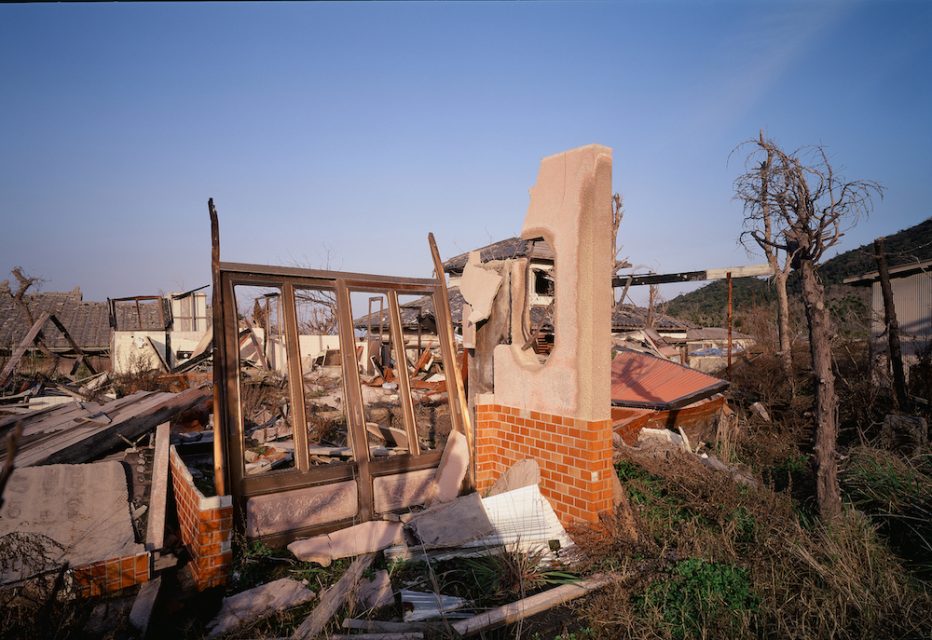 Katsumi Sunamori – From the series “Unzen, Nagasaki” (1993-95)
Katsumi Sunamori – From the series “Unzen, Nagasaki” (1993-95)
Elsewhere in the same novel, Endo calls such unreasonable quietness, which is to say the “silence” of God, “the tremendous silence of the night.” He adds, “It was not that the stillness of the night was completely without sound. Just as the darkness floats over the trees, the awfulness of death suddenly descended upon him, filling him with terror.” (Ibid, p. 218) Surely this very stillness or silence was a soundless landscape filled with the same contradictions as the “revelation” that Sunamori witnessed at the Unzen disaster site. Let me quote once again from an essay by Kazura Sunamori.
Beginning in April 1993, two years after the [1991] eruption, volcanic activity at Mount Fugen, which had shown signs of abating, triggered pyroclastic flows and lahars, and the rain falling on the mountain mixed with deposits from these events to form large-scale debris flows. The mud mixed in with the water produced a flow of liquid with a specific gravity greater than that of water, as a result of which earth and sand overflowed from the Mizunashi River and automobiles and large rocks were swept downstream. Sunamori’s photographs show places where people once lived three years after they were destroyed and abandoned. Devoid of people, these towns are enveloped in silence, and our assumption that towns are filled with sound is overturned. Our sense that something is wrong unnecessarily arouses a feeling of uneasiness. Signs that people lived there for a long time pervade the remaining houses, implements and other vestiges.
Flowers, weeds and other natural things vigorously grow over ruins, and vestiges of human habitation are covered in ash, buried, broken into pieces and weathered. The hot air from lahars singes everything around them in an instant, transforming the landscape, which for three years has been surrounded by silence as time stands still. The ground floors of farm and private houses are buried in debris from lahars, but the sun continues to rise and set with regularity. Remains that barely managed to retain their form slowly perish, like an open-air burial. In which sense perhaps this is a sacred place.
(Both extracts from Kazura Sunamori, “Unzen/Fugendake saigai shashin kara yomitoku Sunamori Katsumi no riarizumu” (Katsumi Sunamori’s realism as interpreted based on his photographs of the Mount Unzen-Fugen disaster), underlining added, paragraphing omitted)
Both of the above statements by Kazura Sunamori describe her impressions on observing Sunamori’s photographs, but at the same doesn’t a mercilessness of the same quality as the “solemn silence” that Endo described in which after the execution of a human being only the sounds of flies could be heard, which is to say the movement of nature without God, also make an appearance ominously? If so, is not this what – not “silence” or “stillness” – Sunamori paradoxically referred to as “revelation” throughout the series of photos of Unzen titled Mokushi no machi (Town of Revelation)? Here, the presence of God is at once summoned and rejected. Such is the tremendousness of the terrifying trial by fire that the Portuguese missionaries and priests never imagined. Today, in the wake of the Tohoku earthquake and tsunami, as a single flesh-and-blood person who has inherited this fear and must weave a life in a corner of this Japanese archipelago, I want to rename the Unzen townscapes captured by Sunamori “revealing landscapes.”
The exhibition “Katsumi Sunamori – Implications of the Scenery” (guest curator: Noi Sawaragi) is on view through August 30, 2020 at the Maruki Gallery for the Hiroshima Panels in Higashi-Matsuyama, Saitama.
